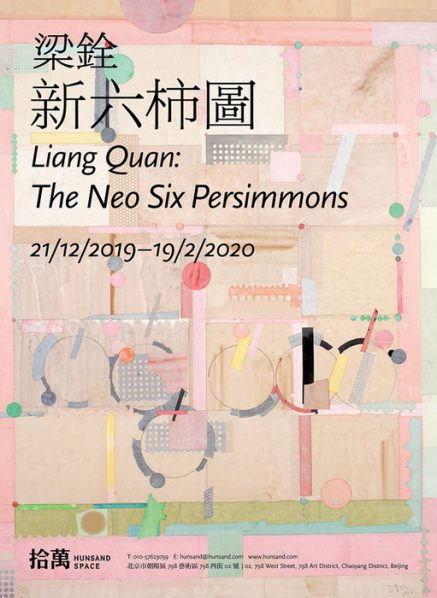
Hunsand Space is delighted to present Liang Quan’s solo exhibition, “ The Neo Six Persimmons”. The Six Persimmons is the work of Southern Song Dynasty painting Mu Xi’s work, who composed the fruit in natural forms, his used of ink, shade, yin/yang, and various types of brushwork. Over time, this work allows the viewers to perceive the Zen realm where “truth prevails”. Looking at Six Persimmons, one wonders what were on Mu Xi’s mind when he painted this work, what the artist has experienced? To a certain extent, the “truth” embodied in Mu Xi’s persimmons is synonymous to the ones of Liang Quan, both embody the artists’ true sensibilities. As Liang Quan describes this sensibility in his own words, “I picked up a piece of grass off a carpet-like lawn, and I stared at it for half a minute before I looked away. Only in this brief moment, I could no longer identify the grass from the landscape of green – the world is sophisticated and truthful, where everything seems insignificant.
Born in the late 1940s, Liang Quan had studied printmaking in the U.S. in the 1980s. Upon returning to China, he taught at the then Zhejiang Art Academy (currently the China Art Academy), before he relocated to Shenzhen. Liang Quan has been profoundly compelled by the disparities between the arts of China and the West, in his own words, “The Chinese have extracted a set a concise context and realms on the natural elements such as wind, rain, dawn, and dust, or even of the artificial landscape, as we have seen in the painting Eight Views of Xiaoxiang. Such visions are unfound in the Western visual language, even though there are works of art that portray the ocean, forest, and still life, without sublimating them into intellectual sensibility and artistic conception. Without making any cultural ranking, the differences between them are apparent. For which, I contemplated on how to integrate the two visual traditions I have acquired in my studies – the abstract, geometric and modernist mode of expression, where I could adopt the vision for abstraction to express such ineffable realms and continue to experiment in this direction”.
On view in this exhibition are works inspired by scenic areas from the natural environment around Hangzhou. In Listening to Orioles Singing in the Willows, Peak Flying, Xiao Yingzhou and Shili Langdang and others, Liang Quan has translated the reality of these natural sceneries to his own visual language, an approach synonymous to painting traditional Chinese landscape paintings, using his “ink and colors” to depict the landscape before his eyes. Meanwhile, the natural landscapes he has perceived have been translated into his language of “abstraction”, ones that remind one of the music of Johanne Bach, to represent the artist’s experience of flora and fauna. Here, the notion of “tradition” afforded us different kinds of visual language to experience the sensibilities once conveyed in Mu Xi’s Six Persimmons from the Southern Song Dynasty.
About the artist
Liang Quan, born in 1948 in Zhongshan, Guangzhou, grew up in Shanghai, and currently lives and works in Shenzhen. Liang Quan’s recent solo exhibitions include, “Watching the Clouds Go By: Liang Quan’s Creative Style and its Changes”, Hive Center for Contemporary Art (Shenzhen); “Amassing the Essence: Thirty Years of Painting by Liang Quan”, Hive Center for Contemporary Art. His works have been widely acquired by art museums and institutions abroad and at home including, National Art Museum of China, Shanghai Art Museum, Zhejiang Art Museum, Guangdong Art Museum, The British Museum, M+ Museum, Hong Kong, LV Foundation, Neue National Gallery in Berlin, Germany, etc.
About Hunsand Space
Hunsand Space is founded at No. 211 Caochangdi Art District in 2014 and relocated to 798 Art District in 2018. Remaining vigilant about the conventional ways of presenting art exhibitions in the white cube, Hunsand Space aims to take the semantics and syntax from the language of contemporary art as a point of departure and to extend them into broader fields. Through its vigorous exhibitions and projects, Hunsand Space hopes to activate the overlooked aspects in contemporary culture and to bring the value of contemporary art into our lives.
About the exhibition
Date: 12/21/2019 – 02/19/2020
Opening: 12/21/2019 Saturday 4pm
Venue: Hunsand Space | 02, 798 West Street, 798 Art District, Chaoyang District, Beijing
Tel: 010-57623059
E-mail: hunsand@hunsand.com
Courtesy of Hunsand Space.




























